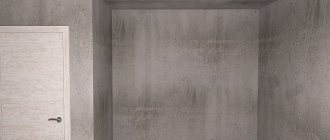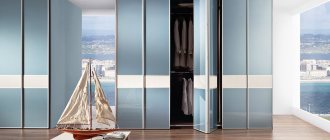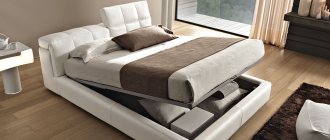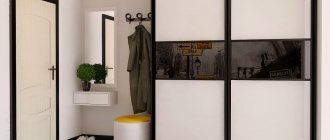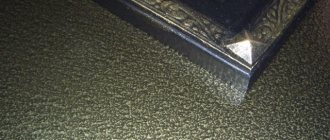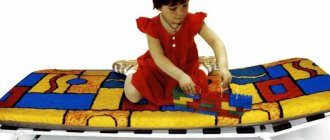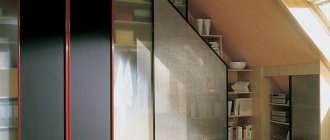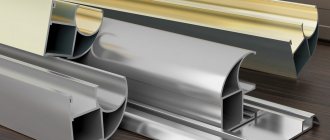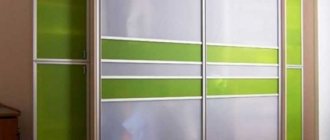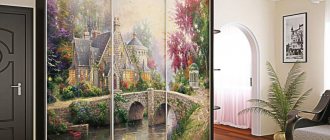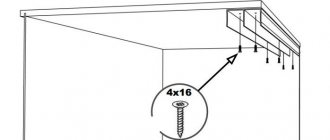Hanging system for interior partitions and wardrobes
Introducing the threshold-free Aluforce® Felix sliding door system. The hanging system assumes universal use - sliding wardrobes, dressing rooms, screens, interior and interior partitions.
The system is based on the top (ceiling) support - the guide beam, and does not have support on the floor or bottom of the cabinet. It is possible to attach the top rail to both the wall and the ceiling. Acceptable door dimensions are from 450 mm to 1200 mm. Door leaf weight up to 75 kg. The thickness of the door filling is up to 10 mm.
As part of the system
- Top horizontal profile (1.4 mm - 2.4 mm; 5900 mm)
- Bottom horizontal profile (1.1 mm; 5900 mm)
- Reinforced top guide rail (2.4 mm - 3 mm; 5900 mm)
- Decorative trim (1.1 mm; 5900 mm)
- Biaxial top roller with POM thermoplastic wheels
- Platform for attaching the upper roller
- Upper position stop
- Bottom buffer roller with silicone wheels
- The system is integrated into a symmetrical vertical profile Premial® I, P, N.
Interior without borders
The doors are suspended on upper rollers, which move inside the guide rails. The upper rollers are biaxial, the thickness of the steel walls is 2.2 mm, the wheels are made of abrasion- and deformation-resistant POM thermoplastic. The rollers consist of a housing with wheels, a mounting axle and a mounting platform. The upper rollers have an almost silent, easy movement: a polymer sound-absorbing gasket is integrated into the mounting hole. The position stop secures the door in the closed position and prevents the door from jumping out of the top guide. The structural elements of the upper guide and fittings are hidden by a decorative overlay, giving the system an aesthetic, finished look.
A lower buffer roller is installed on the floor/bottom of the cabinet, securing the doors from below and preventing the door from swinging. The roller is invisible either in the closed or open position of the door. The roller wheels are silicone, with sealed bearings. The lower rollers are enclosed and protected from dust and maintenance is not required.
Guides for sliding wardrobes: general information about fittings
Guides, as part of furniture fittings, perform a vital function. Thanks to these elements, the sliding system together with the doors operates easily, freely and quietly. The operating principle of this design is quite simple: the door leaves move along sliding wardrobe rails using rollers or balls.
The Versailles sliding system is equipped with reliable and durable fittings
Versailles is the most common and popular type of sliding system, which is found in compartment-type cabinets. This popularity is due to the presence of durable, reliable and high-quality components, as well as easy-to-use internal filling elements. Sliding systems are additionally equipped with stoppers, seals and rollers for sliding wardrobes. Guides with such a complex design eliminate the possibility of door panels being skewed and closing randomly.
Sliding system components and requirements for guides for sliding doors
The width of the guides for the sliding wardrobe and other parameters of the fittings should be selected taking into account the characteristics of the door leaf. In this case, the weight and dimensions of each sash, as well as the material from which they are made, must be taken into account. Guides for sliding systems usually come with furniture, so there is no need to purchase such elements separately. However, they may be needed if the fittings fail and require complete or partial replacement.
Helpful advice! If you select guides that meet basic quality requirements, then such products can be used for a long time.
If the installation of guides for wardrobe doors is done correctly, then the opening and closing of the door will occur in the same plane. Together with other fittings, this type of product is part of the sliding system. Requirements for guides:
Guides for sliding doors are selected based on the weight and material of the doors
- High level of strength - good strength characteristics ensure a long service life of the sliding system, even if it is used regularly.
- Aesthetics – the guides must match the style of the room where the cabinet is located, as well as the design of the furniture itself.
- Convenience - the sliding system should be so simple and easy to use that any user can open and close the cabinet doors without any problems.
The standard equipment of the sliding system is the same in all compartment designs. But the list of additional accessories may vary depending on the cabinet model and its internal contents.
The sliding system includes the following elements:
- upper and lower guides for the wardrobe, along which the door leaf moves;
- profiles with vertical and horizontal installation types for reliable fixation of all elements of internal filling;
- closers for smooth movement of the sashes;
- silicone seal;
- a system consisting of lower and upper rollers for sliding wardrobe doors, which ensures their free and silent movement;
- screws as fasteners;
- stops for fixing the door leaf in a certain area (they look like spring brackets);
- brushes.
Guides must be strong, durable and easy to use
Types of guide profiles for sliding doors: classification by type of material
When choosing guides for a wardrobe, you must pay attention to the material they are made of. The following raw materials are used for the production of these products:
- plastic;
- aluminum;
- steel.
Plastic guide profiles have the lowest price. Such products do not have a long service life and high reliability. They can be used without problems for 5-7 years. For this reason, many consumers prefer to avoid purchasing furniture with plastic components.
Helpful advice! To extend the service life of the sliding system, it is advisable to use plastic sliding wardrobe guides only in combination with parts made of metal.
Guides for wardrobe doors are made of plastic, aluminum or steel
Steel is used to make fairly strong and reliable products. However, the size of the guides for the wardrobe, including their thickness, must be selected taking into account the parameters of the door leaf. If the fittings are selected correctly, the service life of the sliding system will be long. The price of such profiles is considered affordable for most buyers and, as a rule, it corresponds to the quality level of these products. Sometimes there are options that are not as durable and easy to install as we would like.
The highest quality parts are made from aluminum. These profiles are usually installed in expensive and luxury models. Aluminum slides are designed for cabinets that are 4 m or more in height. Such products are distinguished by an extensive palette of colors and a large selection of decorative design options.
Installation of lower and upper rails for a sliding wardrobe
The upper guide profile is fixed at the top of the cabinet. Self-tapping screws are used to secure this fittings. Press washers and universal-purpose screws are suitable as fasteners, but they must have a countersunk head.
Top guide installation diagram:
- Holes of 4 mm in size should be made in the guide profile, which will be located in increments of 30 cm. A drill can be used for this.
- If universal-purpose screws are used as fasteners, you will need to make a countersink in each hole.
- The profile must be installed in the appropriate area of the cabinet and leveled.
- After this, the part is fixed with fasteners.
The bottom rail of the sliding wardrobe has a similar structure, but it is used as a supporting part.
To install the top guide you will need self-tapping screws, press washers and screws.
Installation diagram of the lower guide profile:
- Holes of the appropriate size are made in the profile.
- You should not immediately fix the fittings, since according to the installation technology, this element should be shifted 2 cm inside the cabinet. In this case, you must use a level.
- Once the exact installation location has been identified and the guide is level, you can fix this part with self-tapping screws.
Important! Since the bottom rail is located inside the furniture, you need to make sure that it will not deform the internal contents, such as drawers and baskets.
Recommendations for selection
Guides together with rollers play a major role in the durability of sliding systems. The correct selection of structural components is important.
Requirements for guides:
- there should be no displacement of rollers and guides for sliding doors;
- must ensure smooth, pliable sliding of the web;
- must ensure tight closure of the product;
- must ensure silent passage of the retractable sash.
Rollers are necessary to ensure smooth sliding of the material. They can be rubber, Teflon, plastic or metal. Durable sliding rollers are made of rubber-coated metal and are wear-resistant.
Modern high-quality rollers can withstand loads of up to 100 kg, have sealed bearings on the axle, are protected from moisture, dust and do not require lubrication. The quality of the roller and bearing is affected by the presence of a special spring. When choosing a sliding mechanism, it is necessary to take into account the manufacturer of the system. The more reputable the manufacturer, the better.
It is necessary to determine the material from which the guides are made: plastic, steel or aluminum. Because the quality and cost of the material are of great importance. Plastic products are low cost, but most often they are fragile. As a result, their introduction is not recommended if the products are made of heavy glass. Almost all manufacturers of devices for sliding systems recommend aluminum rails, which have many advantages.
Standard series of door profiles (Standard)
Designed for doors of built-in wardrobes and custom-made wardrobes.
- Doors can be made from standard system aluminum profiles for:
- sliding system;
- swing system;
- suspension system.
The standard system uses 4 handle shapes:
| Classic C | Classic N | Trend | Style |
The entire collection of profile colors is available
- There are 14 profile colors in the warehouse program:
- matte chrome;
- matte gold;
- matte bronze;
- matte champagne;
- white;
- dark wenge;
- smoky oak;
- chateau oak;
- country oak;
- walnut;
- dark bavria oak;
- champagne gloss;
- bronze gloss;
- wenge dark gloss.
SEZAM aluminum profile table
| Top guide, wall thickness 1 mm. Top rollers with a size of 38.5 mm are used |
| Bottom guide, thickness 1 mm. It has a semicircular shape to reduce the contact patch at the point of contact with the roller. This reduces the noise from opening the door. |
| Horizontal top profile (top frame). Designed for assembling a door with filling, 10 mm. With seals you can use 4 and 8 mm filling |
| Horizontal intersectional profile (middle frame). Designed to strengthen the mechanical strength of the door structure and connect different door fillings (chipboard / mirror). |
| Horizontal intersectional profile without self-tapping screw (middle frame without self-tapping screw). Designed for connecting different door fillings (chipboard / mirror). |
| Horizontal lower profile (lower frame) Designed for assembling a door with filling, 10 mm. With seals you can use 4 and 8 mm filling |
| Single track top and bottom guides |
In a sliding compartment system
The following rollers can be used:
- standard roller;
- reinforced roller ensures silent door opening (top roller with bearing);
- roller with fixation in the lower guide;
- a set of closers (universal) ensures smooth closing of the door.
For swing
systems must be used:
- guide for swing;
- pivot mechanism.
For the hanging
system you must use:
- guide for hanging;
- set of rollers for the suspension system.

